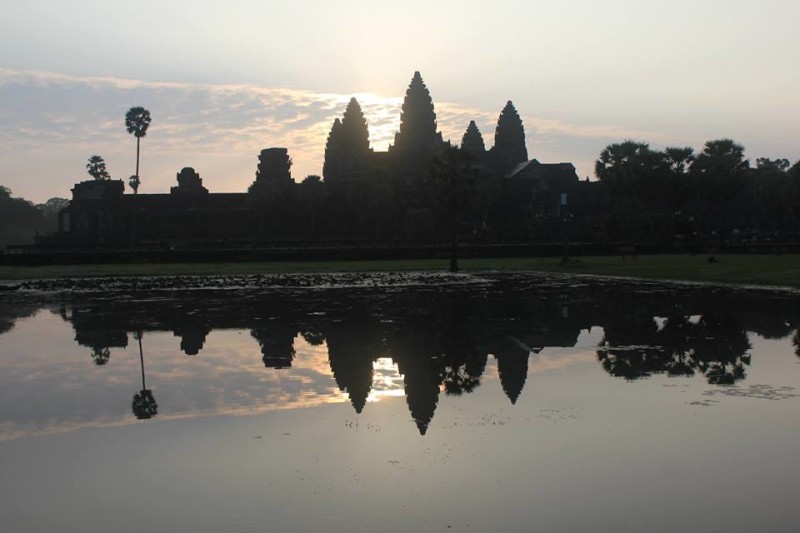Cambodia’s Shadow

I’ve had the good fortune to travel to quite a few countries. I’ve lived abroad for nearly 5 years now, but I’ve never been a country that was so difficult to visit as Cambodia. It was not difficult in the sense that it is hard to move around or find a place to stay. And Angkor Wat was certainly a pleasure to see. However, Phnom Penh was one of the most heart wrenching experiences I’ve ever had. It left me down and not so sure how to conduct myself, and the reason resides in the infamously brutal and genocidal Khmer Rouge. Though they are no longer there, their shadow looms large and heavy over Cambodia still.
From 1975-79, the communist party, the Khmer Rouge, took control of the country under the direction of Pol Pot. It was their mission to create a “communist utopia” to confront the evils of modern industrialization. What resulted instead was one of the most evil, violent, and senseless periods of horror in modern history. The result was the death of over 3,000,000 people. Who were the victims of these crimes? Anyone who could be painted with the brush as an ‘other’. As the goal was to create a communist utopia, the peasant farmers were taken as model citizens. Anyone else, or anyone who could be conceived of as standing in opposition to the Khmer Rouge was tortured and executed. Having a bachelors degree was a punishable by death. Teachers, doctors, engineers, professionals of any kind, the elderly, cripples, anyone wearing glasses, or anyone suspected of opposing the Angkar (the name of the government under the Khmer Rouge) were all killed without trial.
The Khmer Rouge did not have the industrialized luxuries of other maniacal genocidal regimes throughout the 20th century. Bullets, guns, gas chambers and the like were largely beyond their means. Instead, the majority of people were murdered with hand tools: hoes, axes, knives, saws, crowbars, picks, shovels, and the like. Many victims were killed while kneeling before large mass graves in areas now known as “killing fields”. Worse still, the “final blow” was often insufficient to actually finish the job. Many victims, still alive, toppled onto the mound of bodies below. To deal with this problem, the Khmer Rouge soldiers would dump large quantitates of DDT in the graves to poison whoever was left. They used so much of the this chemical poison that decades later, people who found the mass graves and began to excavate them actually fell victim to the poison that still lingered in the soil. For this reason, many of these graves will forever be left where they are.
Over 100 killing fields were spread throughout the country. Sadly, these fields are one of the main tourist attractions in Phnom Penh today. At the main killing field in Phnom Penh, there is an audio tour available. A headset with a small digital audio device allows people to walk around in silence and listen to certain tracks at specific intervals. In my personal experience, I felt like a shell of a person listening to the atrocities that took place there. The audio tracks allow everyone to have a personal experience of learning and honoring the people who died there. It’s quite horrifying to imagine what took place. Many people were brought to the fields thinking they were being relocated to a new living situation. Most of the killings took place at night, under bright white flood lights powered by diesel generators. To conceal the screams of the victims, Khmer Rouge patriotic songs were blasted in the evening air. As part of the audio tour, they play an audio example of what these victims probably heard before they met their unavoidable fate. The horrific truth is that death was likely a welcome release after the horrendous torture many of the victims endured leading up to their trip to the killing fields.
Presently, there is an sacred alter in the center of the killing fields. There, more than 8000 skulls, uncountable other bones, and execution weapons have been excavated from the fields and put on display. Each of the skulls has been examined by forensic specialists and marked small stickers. The stickers indicate the type of weapon that was likely used based on the shape and depth of the fatal blow. In the bottom of the alter lay piles of victims clothes. Many of these clothes were taken off the bones of the victims in the mass graves. But every year, due to heavy rains, more bones and clothes continue to reach the surface. Employees of the killing fields must make regular rounds in order to clear newly emerging teeth and other garments that have just now reached the surface. Particular areas have been closed off to show examples of how these clothes surface periodically.
This reign of terror was the result of a horrendous cocktail of ignorance, fear, hate, and self-aggrandizing megalomania. Pol Pot was terrified of losing his position of power and consequentially, anyone who was suspected in the slightest of opposing his army was tortured to death, or tortured to confession, and then executed. As horrifying a site as the killing fields are, perhaps the true heart of darkness is encapsulated in a ex-school in the middle of the city. It was transformed into a prison and interrogation center, but was primarily used as a torture center for the Khmer Rouge.
The name of this hall of horror is known as Tuol Sleng, now often called S-21. Suspicion of any kind could land a victim here. Fear of the Khmer Rouge left family members ratting out other family members, sometimes unknowingly, sometimes for relief from their own torture. If you were taken in to the prison, there was nothing you could do to escape. The organizing government of the Khmer Rouge was known as the Angkar. If a victim would plead his or her innocence, a common response would be “The Angkar is too wise to make mistakes. You are in here for a good reason.” And then the guards would proceed to torture the victims until that reason was confessed.
In S-21, there are various buildings and rooms used for different purposes. The first building is used as a prison and interrogation rooms. The interrogation rooms would be equipped with a metal bed frame, and occasionally a desk and chair, for the interrogator, not the victim. The victim would be shackled around the ankle with a metal bar, and attached to the bed. Young guards would then beat the prisoners in shifts. At times, one guard would beat the prisoner until the guard tired, and would then allow a fresh guard to pick up the beatings from there. Sometimes beatings would take place in teams with whips, boards, bars, or whatever tools of torture seemed appropriate. The US government may be happy to overlook the fact that water boarding was among the torture tactics employed by the Khmer Rouge.
Presently, there are pictures in these interrogation rooms of the victims on there metal cots. Often they lay on or near the cot in a pool of their own blood. Many of the cells are still stained with blood to this day. After being beaten, many of the victims would be forced to carry the guards on their backs up the stairs, back to their own rooms, if they could walk at all. Many people were tortured to death.
In the main courtyard, there is a tall wooden archway where students of the school could play and exercise on bars. Under the Khmer Rouge, this arch was was used as an “interrogation device” where victims would have their arms tied behind their backs, and would then be hung from their arms. They would then be beaten and while hanging. It was common for the victims to loose consciousness, and then they would be given strong herbs to help revive them so they could be strung up again and the questions could continue. Large urns full of putrid water were also kept by the base. Many victims would be lowered, and nearly drowned in between being strung up and beaten. If the victims confessed to their alleged crimes at any time, they would be punished further with torture or would be brought to the killing fields.
The classrooms of this school were transformed into prison cells. Many rooms were divided into brick cells, while others were boarded off with wood cells. Other rooms were used for group cells. The buildings are multiple stories tall, with walkway corridors on the outside. To prevent the victims from attempting suicide, barbed wire was put over the balconies. Other rooms were full of devices crafted especially for torture.
Among the grotesque devices included barrels of water with handcuffs at the bottom. Victims would be strung up by their feet above the bucket, which would be filled to a height above their shoulders with their hands bound to the bottom. Similarly, tubs were constructed where victims feet could be shackled to the bottom, with their hands cuffed on the sides. The victims would be forced to lay face down. Other wooden shackles laid victims on their backs with their hands cuffed above their heads with other cuffs around their ankles. Some women had their nipples cut off. Others were raped by multiple guards and left for dead. Babies were ripped from the hands of mothers. In the killing fields, there is a specific tree known as “The Killing Tree.” When it was found, there were bits of brains still attached. Guards would murder small children by holding their ankles and batting them against it. A mass grave was located next to the tree where the bodies could be thrown.
Overall, it’s simply hard to understand how people could allow their worldview to become so askew and full of hate. The Khmer Rouge is an example of the extreme madness that people are capable of. And to think that these atrocities took place less than 40 years ago. Around Phnom Penh, there is a blatant lack of elderly people. 1 in 3 people were murdered under the watchful eye of the deadly regime of Pol Pot. If this was your or my country, we could have been the victims ourselves. At the very least, our parents would have been subjected to the atrocities. One of the most surprising things to me is how easily the world can overlook these horrific events. I personally never experienced a history lesson that even began to touch on the terrifying past of the Cambodian people. But this historic event still looms over Cambodia. And though it was one of the most difficult places I’ve ever visited, I will be unable to forget what I saw and learned. I will take these lessons with me as motivation to spread the cure to these atrocities. Ignorance, hate, fear was the cause, so it is our responsibility to foster knowledge, wisdom, love, compassion, acceptance, and a desire to help all. We must learn to care for everyone. The cure to this sort of madness is a wider world-identity where we are all part of the ingroup. So in the meantime, I love you all and I urge all of us to seek ways to accept our differences and act towards everyone with loving-kindness, especially when we don’t agree.
Comments are closed.


